In retrospect: I was working as a Product Manager for Sybase iAnywhere when we got acquired by SAP and my team was transformed into an “emerging technologies” team by some great post M&A organizational maneuvering. I then got the lucky opportunity to work with the Barcode of Life community from the University of Guelph. In addition to gaining the opportunity to help a noble, global environmental cause, this initiative introduced me to the field of biogenomics and DNA sequencing technology. It also gave me a chance to practice Design Thinking after my SAP fellowship (where I learned how to practice and facilitate sessions via the d.school at Stanford). What resulted was a beautiful iPhone app we co-launched called LifeScanner, a mobile application designed to crowdsource “DNA barcodes” from all living life, that is still in existence today. This post details the Design Thinking process we employed to create the mobile application. Biogenomics is really an emerging technologies field and this early exposure eventually lead to my exploration of commercial applications for this technology, specifically within food fraud (another later post). In summary I’m very grateful for this time I had early-on in my career as I was learning heaps and having fun creating with brilliant people, much smarter than me.
ORIGINAL POSTS FOLLOW FROM DECEMBER 11, 2013 & FEBRUARY 4, 2014
(https://blogs.sap.com/2013/12/11/international-barcode-of-life-meets-sap-design-thinking-a-real-life-software-development-example/ & https://blogs.sap.com/2014/02/04/international-barcode-of-life-meets-sap-design-thinking-a-real-life-software-development-example-2/)
PART 1
I would still say I am a newbie when it comes to Design Thinking, having been thrust into this world almost two years ago. What I do think is hard for some to grasp is the idea that Design Thinking is a mindset and not a strict process to adhere to. For some disciplines (e.g. engineers and computer scientists) this mindset may be confusing because it is not a concrete theory you apply prescriptively. Consider – can you detail instructions on how to construct a work of art or similarly a software innovation?
But I can’t pretend that I too don’t empathize with the logic lovers out there (I did study math after all). Therefore I dedicate this blog entry to those like-minded pragmatists who love to see applied examples. So here’s how we used Design Thinking on our most recent collaboration project with the International Barcode of Life (iBOL) organization —
(Disclaimer: this is not a prescription for applying Design Thinking, but merely a highlight of how we applied to it to a development project within Emerging Technologies at SAP Waterloo)

So a long, long time ago, in a far-away cold place in Waterloo, Canada we met up with an amazing organization called iBOL. We met and agreed upon the scope of the problem: how might we engage people around the world with the rich, 10 years in the making, Barcode of Life data (essentially DNA barcodes of life on Earth).
Our multidisciplinary dream team (another important concept in Design Thinking) consisted of 6 people: a Design Thinking coach (I mentioned we were newbies, right?), a user experience designer, a graphics designer, a computer scientist (CS-er for short), a product manager (me), and a biologist from the University of Guelph.
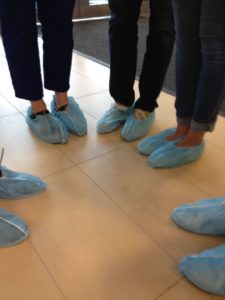 We spent a lot of time conducting 360 degree research including a site visit to the Biodiversity Institute of Ontario (see our bootie picture to the left) and led over 25 user interviews. We selected people with different backgrounds and interest levels in nature (for example, hobbyists or travelers) and even visited an Elementary school to get feedback from children. For each interview we tried to have two people present, someone to ask the questions and someone to silently observe what the interviewee said, felt, thought, and actually did.
We spent a lot of time conducting 360 degree research including a site visit to the Biodiversity Institute of Ontario (see our bootie picture to the left) and led over 25 user interviews. We selected people with different backgrounds and interest levels in nature (for example, hobbyists or travelers) and even visited an Elementary school to get feedback from children. For each interview we tried to have two people present, someone to ask the questions and someone to silently observe what the interviewee said, felt, thought, and actually did.
We then synthesized the interviews by having observers read out their findings, while the rest of the team recorded pictorially (where possible) their insights on post-it notes. From this exercise we noticed certain meta-themes amongst most of our interviewees. For example, most everyone’s level of affectedness was directly correlated to their level of interest (i.e. someone was more likely to interact with biodiversity data IF they had an interest in it to begin with). While some meta-themes were no-brainers (e.g. people often start at Google if they want to identify an unknown species), others surprised me (e.g., while someone may be SUPER passionate about a hobby they often think their interests are not important enough to share with others unless they are in their relatively small, closed network).
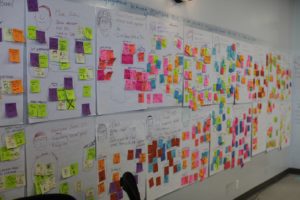 And this brings me to the end of the Synthesis stage. In Part 2 I will discuss what we did within Ideation (including personas and some wild ideas we had), Prototyping (including a couple of prototypes we came up with) and how we went about Validation (including user testing).
And this brings me to the end of the Synthesis stage. In Part 2 I will discuss what we did within Ideation (including personas and some wild ideas we had), Prototyping (including a couple of prototypes we came up with) and how we went about Validation (including user testing).
PART 2
I left off our Design Thinking journey at the end of the Synthesis stage where we came up with a list of meta-themes from the various interviews we conducted from all walks of life. What emerged from the meta-themes were two distinct personalities:
Digital Surfacers: someone who uses digital systems to look for information but is mostly interested in basic information. This person is mostly interested in getting an answer they may have about a particular subject like biology, but they are not interested in knowledge that doesn’t affect them.
Digital Deep-divers: someone who uses digital systems to look for information they want. This person is very interested in biology and wants to learn more about topics they search online. They are not satisfied with a simple answer to a question.
Based on these personalities we developed the following two personas in the below chart (complete with fictional names and personality traits), each with a unique point of view (POV) based on their needs and insights we had about them. We then massaged our original How Might We (HMW) statement for each POV.
| Digital Surfacer: Justin Palmer | Digital Deep-diver: David Molder |
|
|
|
HMW distribute Barcode of Life information to Justin augmented with useful context that he has not seen before so that he can reflect and entertain himself and grow his social circle through sharing? |
HMW enable David to join a community where members share their passions and expertise in science/biology/nature in a place that is visually accessible and inviting to both amateurs & pros? |
And then FINALLY we started to brainstorm solutions for each HMW statement during the Ideation stage. We started arbitrarily with Justin Palmer first. Still working in our multidisciplinary team, we threw out wild and crazy ideas. But we stopped shortly after. Why? Our team came to the consensus that Justin didn’t really need Barcode of Life and a lot of our ideas were really ways to disguise or subtly trick Justin into engaging with this rich biodiversity data. So we circled back to our David Molder persona and started ideation allover again.
(Aside: this two steps forward, one step back phenomenon is not uncommon in Design Thinking, and hardcore Design Thinkers are quick to point out that Design Thinking is not a linear process. For example we could have decided to do more 360° Research at any time or Rescoped the problem.)
So back to ideation, we went for more wild and crazy ideas to meet David’s passion for science. Some of our top refined ideas included specifics around location-based biodiversity data, user recognition, crowd sourcing, and visual representations of DNA barcodes. We then jumped right into prototyping some of our ideas and actually came up with 2 paper prototypes.
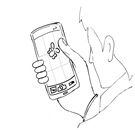
Prototype #1 was a mobile application that simplified the collection and identification of biological species.
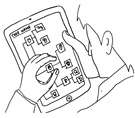
Prototype #2 was a simple taxonomy tree viewer application, complete with the option of creating your own tree.
After we created our prototypes we went out to test or validate our paper prototypes with real users. What we quickly discovered were several areas where we could refine and streamline Prototype #1. On the other hand, we had rather limited engagement with Prototype #2. So we went back and refined Prototype #1 further. We took our paper prototype one step further by quickly translating our paper screens into a mock iPhone application using a prototyping app. And then we tested some more…and then we finally said enough is enough.
We felt we had refined our prototype enough and were ready to take it to a wider audience. We decided to implement a slice of its functionality on then soon to be released iOS7 (we also added some awesome mobility developers to the team) and then got EVEN MORE feedback at the International Barcode of Life Conference held in Kunming, China at the end of last year.
And now? We are working hard towards completing our first V1 (or Minimum Viable Product (MVP) for all the Lean Startup fans out there) of what started as simply “Prototype #1”. We want to get it quickly in the hands of all the Davids out there, or more aptly coined “citizen scientists” – those who have a genuine interest in the world around them and would love to explore and contribute to a project that aims to measure the health of our planet.
But our journey with Design Thinking hasn’t ended, and most likely will never end. With our first general release our real users will provide EVEN MORE feedback as they use it. This feedback will guide our development efforts and future iterations.
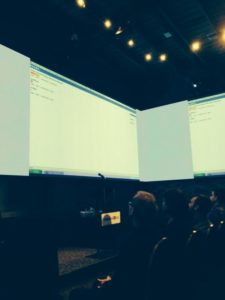 I once sat through a talk by a reddit cofounder who flashed this picture up of reddit V1 during his talk. His point was very similar to how I would like to conclude this blog.
I once sat through a talk by a reddit cofounder who flashed this picture up of reddit V1 during his talk. His point was very similar to how I would like to conclude this blog.
Getting software out the door and getting people to actually use it is really crucial to adoption. reddit looked pretty simple and only had a handful of users in the beginning. But they took the feedback from those handful of users and produced rapid new versions based upon that feedback. They’re not doing so bad now.
So call it Design Thinking, call it Empathetic Design, call it whatever you like. Most importantly just keep the user at the heart of everything you do and hopefully similar to reddit’s adoption, everyone around the world will be barcoding biodiversity in their own backyard, opening their eyes to what is living underfoot, and realizing the impact of their actions on their local environment — all because of one simple, beautifully designed iPhone app.